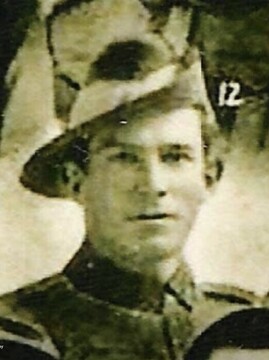STEWART, Andrew Gorman
| Service Numbers: | 2721, Q209935 |
|---|---|
| Enlisted: | 8 February 1943 |
| Last Rank: | Private |
| Last Unit: | 20th (QLD) Battalion Volunteer Defence Corps (VDC) |
| Born: | BALMAIN, NSW, 1 February 1893 |
| Home Town: | Not yet discovered |
| Schooling: | Not yet discovered |
| Occupation: | Not yet discovered |
| Memorials: |
World War 1 Service
| 27 Oct 1916: | Embarked Private, 2721, 47th Infantry Battalion, HMAT Marathon, Brisbane | |
|---|---|---|
| 27 Oct 1916: | Involvement Private, 2721, 47th Infantry Battalion, --- :embarkation_roll: roll_number: '19' embarkation_place: Brisbane embarkation_ship: HMAT Marathon embarkation_ship_number: A74 public_note: '' |
World War 2 Service
| 8 Feb 1943: | Involvement Private, Q209935, Page missing from Enlistment Register | |
|---|---|---|
| 8 Feb 1943: | Enlisted Australian Military Forces (WW2) , Private, Q209935, 20th (QLD) Battalion Volunteer Defence Corps (VDC) | |
| 8 Feb 1943: | Enlisted | |
| 28 Jun 1944: | Discharged Australian Military Forces (WW2) , Private, Q209935, 20th (QLD) Battalion Volunteer Defence Corps (VDC) | |
| 28 Jun 1944: | Discharged |
Help us honour Andrew Gorman Stewart's service by contributing information, stories, and images so that they can be preserved for future generations.
Add my storyBiography contributed by Aubrey Bairstow
Andrew “Gory” Gorman Stewart was a child of Andrew Allan Stewart and Honora (Nora) Condon. He was 23 years old when he enlisted for the Great War on 4 September 1916 at Brisbane, Queensland, Australia. His occupation at the time was farmer and he was described as 5 feet 8 inches (172.7cm) tall. He weighed 160 pounds (72.6kg) and had a medium complexion with blue eyes and brown hair.
Andrew noted his religion as Roman Catholic. He was a single man and listed his mother, who was living at Cooroy, Queensland at the time, as his next of kin.
On 27 October 1916 he boarded the HMAT “Marathon” at Brisbane, Queensland, Australia. He disembarked at Plymouth, England on 9 January 1917 and marched in to 12 Tng. Bn. (Training Battalion) at Codford the following day. Andrew proceeded overseas to France in early May 1917, marching out to 4 A.D.B.D. (Aust. Divisional Base Depot) and joining his battalion on 8 May.
He was wounded in action a month later, on 7 June when he suffered a severe gunshot wound to his left thigh. He was admitted to A.T. (Ambulance Train) and conveyed to 3 Can. G.H. (Canadian General Hospital) where he was admitted the following day. On 11 June, Andrew embarked Boulogne, France aboard H.S. “St. David” for transferred to the Horton War Hospital, Epsom, England.
Andrew was granted furlough leave from 3 August 1917 to 17 August 1917 and report to Tng. Dep. (Training Depot) at Perham Downs. Like a lot of soldiers back from leave, Andrew was admitted on 19 August to 1 A.D.H. (Aust. Dermatological Hospital) at Bulford with gonorrhoea. He was discharged to duty on 1 October, he made his way to Perham Downs and the Overseas Training Brigade. Re-admitted to 1 A.D.H. on 25 October with gonorrhoea, Andrew was discharged on 1 November.
He went to the Convalescent Training Depot and from there, on to No. 1 C.D. (Command Depot) at Parkhouse on 23 November. On 27 November 1917, Andrew made his way to the O/Seas Tng. Bde. where he stayed for some weeks. On 19 December, Andrew proceeded overseas to France, rejoining his battalion on 24 December 1917.
Andrew was awarded the Military Medal “At Dernarcourt (south-west of Albert) on April 5th 1918 was platoon scout. He showed great keenness and cheerfulness under all circumstances. On one occasion during the attack he acted as runner and took a message through enemy barrage to support company. He then returned and commenced sniping and accounted for numbers of the enemy. He also kept constant watch on flanks and kept his officers advised as to the position. His work all through was of a valuable nature.”
The following day, Andrew was appointed Lance Corporal. On 25 May 1918, Andrew was transferred to 45 Battalion in the field.
On 9 August 1918, Andrew was wounded in action, for a second time, when he suffered multiple gunshot wounds to his legs, foot and shoulder. He was transferred to England for treatment aboard H.S. “Princess Elizabeth.” Andrew was discharged to No. 2 C.D. at Harefield on 11 October 1918.
He went A.W.O.L. (Absent Without Leave) from No. 2 C.D. from 1500hrs on 13 November 1918 til 2000hrs on 20 November 1918, possibly celebrating that the war was over. He was severely admonished and 7 days forfeiture pay on 25 November. Andrew embarked England on 4 January 1919 aboard H.T. “Morvada” for his return to Australia. He disembarked Australia on 20 February 1919 still with problems to his left foot. Andrew was discharged from the A.I.F. medically unfit on 09 April 1919.
He re-enlisted for WW2 service in February 1943, stating that he was a married auctioneer (and also piggery manager) from Milton, Brisbane, Queensland. He disclosed his service in 45th and 47th Battalions during WW1 but not his MM. He served with 20th Battalion VDC with service number Q209935 however didn’t advance beyond the rank of Private. When he moved out of the area in June 1944 he was allowed to be discharged. Its doubtful he claimed any WW2 medal entitlement.
His wife Dorothy died in 1973 and Andrew Stewart died in 1983. They are buried at Pinaroo Lawn Cemetery, Brisbane.










